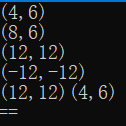书写一个规范的类,一般包含以下四点。其实在许多教科书上都有提及相关内容,为了保证内容完整性,这里再次强调。
1、防止头文件重复包含,请在头文件中加入ifndef...;
2、成员变量设为私有;
3、请使用常函数(公有接口)来访问私有数据成员;
4、对于有参数构造函数,请使用初始化列表(字段)的方式来初始化私有数据成员;
1、防止头文件重复包含,这个是最基本要求,不多说
#ifndef __COMPLEX__ #define __COMPLEX__ // 类、函数声明 #endif // !COMPLEX_H
2、见complex.h文件 line 24、25
3、常函数见complex.h文件line17、18
4、使用初始化字段来初始化成员变量是一个好习惯,具体见我这篇博客。https://www.cnblogs.com/winslam/articles/9078161.html
complex.h文件
1 2 #ifndef __COMPLEX__ 3 #define __COMPLEX__ 4 5 #include<iostream> 6 using namespace std; 7 8 // 初始化列表,const & 传值, 常函数, return by value or reference 9 10 class complex 11 { 12 public: 13 complex(); 14 complex::complex(const double real,const double imag)// 15 : real_(real), imag_(imag) 16 {} 17 double real() const;// 18 double imag() const; 19 complex& operator +=(const complex& cmplx);// 成员函数重载 20 21 ~complex(); 22 23 private:// 24 double real_; 25 double imag_; 26 27friend ostream& operator << (ostream& out, const complex& cmplx); // const 28 }; 29 30 #endif // !COMPLEX_H
注意到27行,是一个友元函数(与上述关键字private无关),当你想要在外部访问对象的私有数据成员的时候,friend函数是一个方法,但是会破坏代码的封装,这时候friend的参数一般都是const类型。
参考我的博客:https://www.cnblogs.com/winslam/articles/9088976.html
complex.cpp文件
1 #include"complex.h" 2 3 complex::complex() 4 { 5 this->real_ = 0.; 6 this->imag_ = 0.; 7 } 8 9 double complex::real() const 10 { 11 return this->real_; 12 } 13 14 double complex::imag() const 15 { 16 return this->imag_; 17 } 18 19 // 成员函数重载 20 complex& complex::operator +=(const complex& cmplx) 21 { 22 this->real_ += cmplx.real_; 23 this->imag_ += cmplx.imag_; 24 return *this; 25 } 26 27 28 complex::~complex() 29 { 30 } 31 32 ostream& operator<<(ostream & out, const complex & cmplx) 33 { 34 out << "(" << cmplx.real_ << "," << cmplx.imag_ << ")"; 35 return out ; 36 }
mian.cpp文件
1 #include<iostream> 2 using namespace std; 3 4 #include"complex.h" 5 6 // 非成员函数重载 7 inline complex 8 operator +(double real, const complex& cmplx) // 复数左+ 常实数 9 { 10 return complex(real + cmplx.real(), cmplx.imag()); 11 } 12 13 inline complex 14 operator +(const complex& cmplx, double real)// 复数右+ 常实数 15 { 16 return complex(real + cmplx.real(), cmplx.imag()); 17 } 18 19 inline complex 20 operator +(const complex& cmplx1, const complex& cmplx2)// 复数加法 21 { 22 return complex(cmplx1.real() + cmplx2.real(), cmplx2.imag() + cmplx2.imag()); 23 } 24 25 inline complex 26 operator - (const complex& cmplx)//复数乘以(-1) 27 { 28 return complex(-cmplx.real(), -cmplx.imag()); 29 } 30 31 inline complex 32 operator + (const complex& cmplx)//复数乘以(+1) 33 { 34 return cmplx; 35 } 36 37 inline bool 38 operator == (const complex& cmplx1, const complex& cmplx2)//... 39 { 40 return cmplx1.real() == cmplx2.real() && cmplx1.imag() == cmplx2.imag(); 41 } 42 43 int main() 44 { 45 complex cp_1st(1.0, 2.0); 46 complex cp_2st(3.0, 4.0); 47 cp_2st += cp_1st; 48 cout << cp_2st << endl; 49 complex cp_3st = 4 + cp_2st; 50 cout << cp_3st << endl; 51 complex cp_4st = cp_3st + cp_2st; 52 cout << cp_4st << endl; 53 cout << -cp_4st << endl; 54 cout << +cp_4st << cp_2st << endl; 55 complex cp_5st(1, 2); 56 if (cp_1st == cp_5st) 57 { 58 cout << "==" << endl; 59 } 60 return 1; 61 }

以上是结果。注意到主函数中出现非成员函数的操作符重载,这个问题留到后面说。这一篇博客写得很简洁,也很基础,但是很重要。